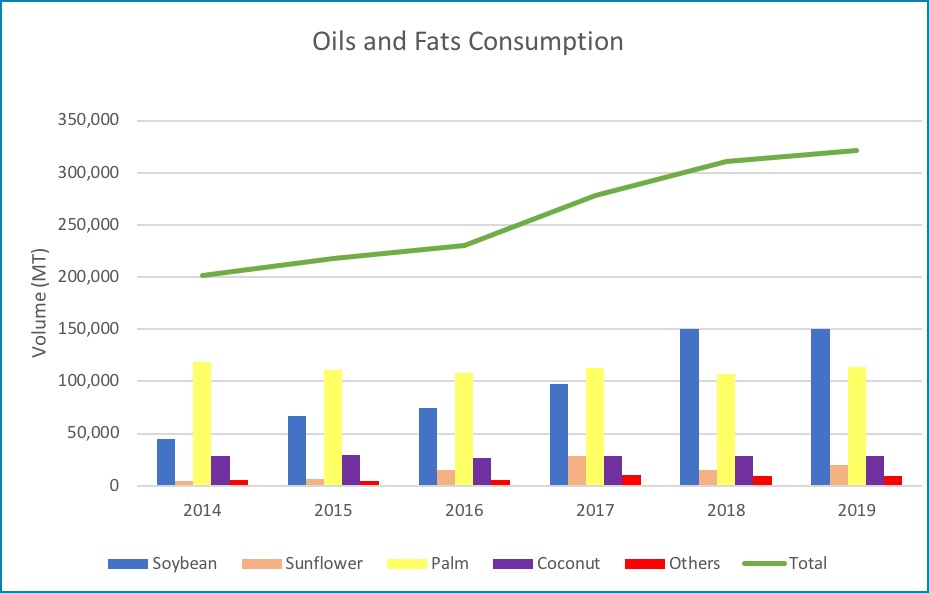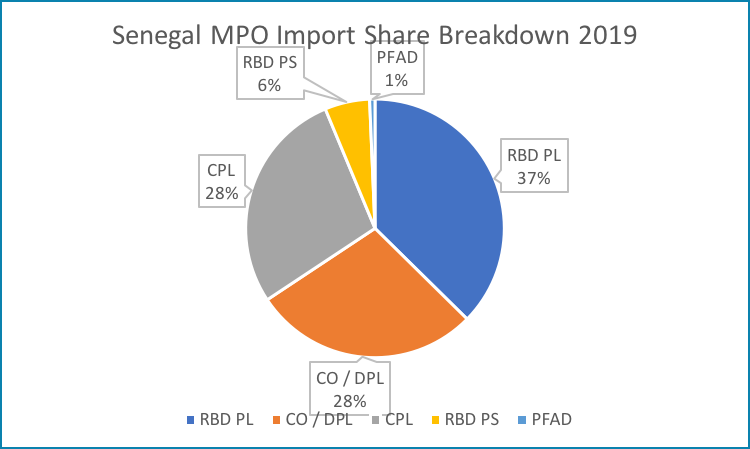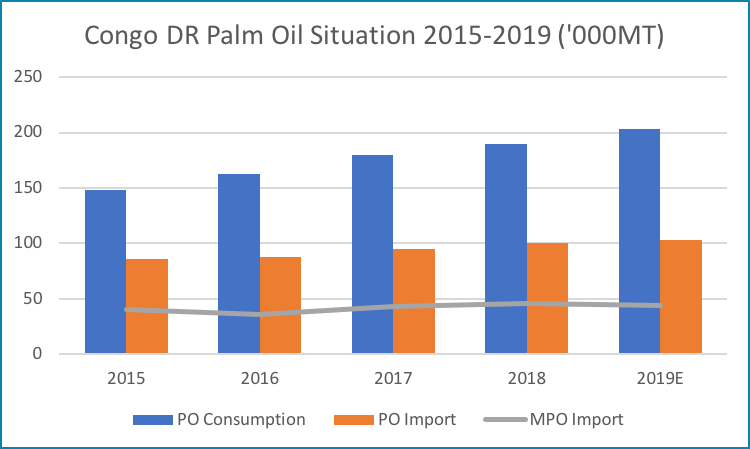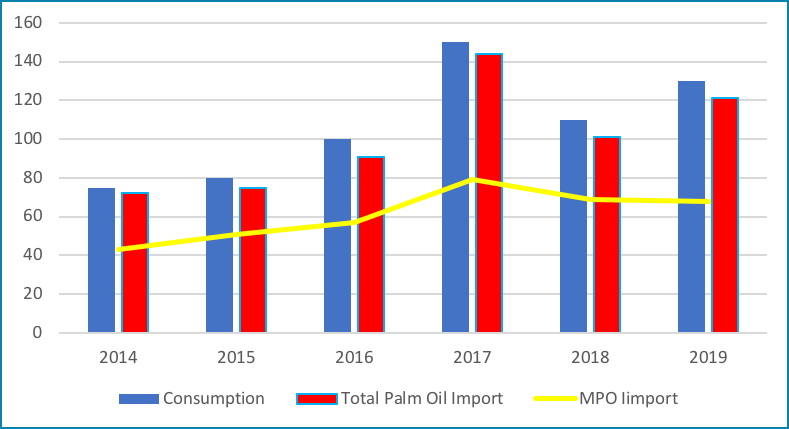Palm Oil Situation in Sub-Saharan Africa
Sub-Saharan Africa with 1.08 billion population, is a place with many opportunities for business and development. As the total population increases over the years, the demand for oils and fats also has been increasing. The estimated consumption of palm oil was at 6.9 million MT last year. While local production of palm oil only amounted to 1.3 million MT, the rest of the palm oil came from mainly Indonesia and Malaysia, to fill the gap. Sub-Saharan Africa imported a total of 2.2 Million MT of Malaysian palm oil in 2019. Looking into Sub-Saharan Africa by region, West Africa imported the most Malaysian palm oil last year, with close to 1 million MT. East African region which is a fast-growing region within Sub-Saharan Africa, imported 759,000 MT of Malaysian palm oil last year (Table 1).
| Regions | Sum of 2019 Volume (Tonnes) | Sum of 2018 Volume (Tonnes) |
|---|---|---|
| East Africa | 725,904.84 | 763,673.69 |
| Central Africa | 227,464.59 | 176,601.32 |
| South Africa | 266,530.13 | 258,442.57 |
| West Africa | 979,610.49 | 1,295,385.94 |
| Grand Total | 2,199,510.05 | 2,494,103.52 |
Table 1: Malaysian Palm Oil Imports by Sub-Regions
This region is less diverse in terms of the type of palm products it imports. Out of last year’s total imports, 92% were palm oil products, and the rest were oleochemicals, finished products and palm kernel oil. Sub-Saharan Africa heavily relies on RBD palm olein, crude palm olein, and crude palm oil.
Major palm oil importers in this region are Nigeria, South Africa, Tanzania, Kenya and Ghana. Some countries like Togo, Benin and Nigeria also considered as re-exporting countries, where they export oils and fats and other goods to other countries, especially to the landlocked countries they border. Apart from the big players, there are also several other countries that import palm oil for their consumption. Malaysia can also take the opportunity in penetrating into other potential importing countries in this region. Five most potential emerging markets are ranked below according to their total consumption and potential growth for imports of palm oil.
1. Mozambique
Mozambique with over 31 million total population, borders 6 countries, namely Tanzania, Malawi, Zambia, Zimbabwe, eSwatini and South Africa. Since 4 of the 6 countries borders are landlocked, Mozambique is also considered a hub for global market in the region. It gives importance to economic, political and social stability similar to its neighboring country, South Africa, that has strong ties with.
Oils and Fats consumption in this country has been on the rise. Total consumption of oils and fats reached 321,400 MT in 2019. This country heavily relies on exports of oils and fats as local production is minimal. Mozambique produced less than 40,000 MT of oils and fats in 2019. The two most consumed oils in this country are soybean oil and palm oil (Figure 1). Apart from that, they also consume sunflower oil, coconut oil and other oils. Soybean oil is mostly used in the retail market as cooking oil and well as other sectors such as HORECA and Fast-Moving Consumer Goods (FMCG).

Figure 1: Oils and Fats Consumption in Mozambique
Since it is a global hub for neighboring landlocked countries, imports of oils and fats get re-exported. Palm oil imports from Malaysia recorded a total of 203,949 MT in 2019 a 5.6% decrease from 2018. This is due to a slow economic situation in 2019 in Mozambique mainly due to the negative impact of cyclones Idai and Kenneth. Most of Malaysian palm oil imports into Mozambique is in the form of crude palm olein. In 2019, 66% of Malaysian palm oil imported into Mozambique were crude palm olein (Table 2). Crude palm olein is refined and goes mainly into FMCG. Apart from that, palm oil is also used in HORECA sector as well as retail market.
| Product Type | 2017 | 2018 | 2019 |
|---|---|---|---|
| Crude Palm Olein | 116,143 | 142,532 | 133,740 |
| CPO | – | 4,907 | 22,404 |
| RBD Palm Olein | 18,506 | 33,494 | 23,975 |
| PFAD | 23,955 | 20,264 | 12,748 |
| Others | 13,475 | 14,753 | 11,082 |
| Total | 172,079 | 215,950 | 203,949 |
Table 2: Malaysian Palm Products Export to Mozambique
Per capita consumption of oils and fats in this country is on the rise. It recorded a 7.65kg per capita in 2014 and a 10.58kg per capita in 2019. Since the consumption is on the increase, there are opportunities for Malaysian palm oil players in few sectors to venture into, such as crude palm olein, or palm oil for FMCG or HORECA sectors.
2. Angola

Figure 2: Palm Oil Import and Consumption in Angola (000 MT)
The Angolan economy, the third largest in sub-Saharan Africa, after Nigeria and South Africa, is dominated by the oil and gas industry, which accounts for about 50% of its GDP and is the primary source of revenue for the country. After a long civil war, the country posted one of the highest economic growth rates in the world, driven by its oil wealth. In the last few years, Angola was severely affected by the fall in oil prices. According to the updated IMF forecasts from 14th April 2020, due to the outbreak of the COVID-19, GDP growth is expected to fall to -1.4% in 2020 and pick up to 2.6% in 2021, subject to the post-pandemic global economic recovery.
Angola is an important Malaysian palm oil importer in the Southern Africa region. The country has a population of 30 million and consumed about 360,000 MT of oils and fats in 2019. Palm oil consumption is about 64% of total oils and fats. In the past five years, the average annual Malaysian palm oil export to Angola was 129,000 MT. In 2019, Most of Malaysian palm oil imports are in the form of RBD palm olein (128,00 MT or 87%) and the rest is cooking oil (13,000 MT) and RBD palm oil (4,500 MT). Angola also imported about 67,000 of Indonesian palm oil last year.
The highest export MPO export figure recorded was 171,000 MT in 2015 when the country was experiencing 4.8% economic growth. With the end of the oil boom, from the end of 2015 to 2019 Angola plunged into a period of economic contraction but its economy is expected to recover next year. There is plenty of room for an increase in oils and fats usage as per capita consumption of about 12.0 kg in 2019 is still low compared to the world average of 30.0 kg. The potential is there for Angola to increase its Malaysian palm oil import to 200,000 per year post COVID-19 and recovery in crude oil price.
3. Senegal
According to Oil World, Senegal consumed 291,000 MT of oils and fats in which palm oil held the largest consumption share at 65.3% in 2019. This is followed by groundnut oil at 23.4%, soybean oil at 7% and others at 4.3%. Senegal imported 30,113 MT of Malaysian palm oil, holding an import share of 24.4% in 2019. Local production of oils and fats is estimated at 131,000 MT in 2019 with groundnut oil being the major oil produced in the country at 99% local production share.

Figure 3: Malaysian Palm Oil Imports into Senegal
HORECA sector in the country contributed greatly to the consumption of palm oil through bulk buying, which presents an opportunity for RBD palm olein cooking oil imports. In addition, with the lowest import tariff in crude palm oil throughout West Africa, at 7.5%, Senegal has the potential to become the re-export destination in the region, with potentials in the form of partnerships or joint ventures to set up local palm oil refineries.
4. Democratic Republic of Congo

Figure 4: Malaysian Palm Oil Imports into Democratic Republic of Congo
Situated in Central Africa, Congo DR holds the second largest population in Sub-Saharan Africa at 89 million. It is also the largest country in Sub-Saharan Africa in terms of land area. In 2019, Congo DR recorded an estimated total oils and fats consumption of 217,100 MT with palm oil accounted for 93% of the consumption share. Congo DR imported an estimated 103,000 MT of palm oil in 2019 of which 42% or 43,657 MT is Malaysian palm oil. The country also produces palm oil locally, with an estimated local production of 111,800 MT.
RBD palm olein constitutes the major import share of Malaysian palm oil at 65% followed by crude palm olein at 19%, crude palm oil at 12% and others at 4%. Palm oil consumption in the country has been increasing as shown in the graph above. This increase is attributed to the increasing demand in retail and household products, as GDP per capita in the country has been steadily increasing for the past decade. With only an estimated annual oils and fats per capita consumption of 2.4 kg, which is way below the world average at 30 kg, there are room to increase the consumption in the country. Congo DR’s booming population will see an increasing demand in the upcoming years.
5. Madagascar

Figure 5: Malaysian Palm Oil Import and Consumption in Madagascar (000 MT)
Situated off the southeast coast of Africa, Madagascar is the fourth largest island in the world. With a population of about 27 million, this island nation has steadily increased its palm oil import from 72,000 MT in 2014 to 121,000 MT in 2019. Import of Malaysian palm oil is also growing in tandem from 43,000 MT in 2014 to 68,000 MT in 2019. Most of Malaysian palm oil imports last year are in the form of crude palm olein (62.6%) and RBD palm olein (27.4%). Madagascar also imported about 53,000 MT of Indonesian palm oil last year.
Madagascar’s economic growth reached a decade-high of 5.1% in 2018 driven by robust activity in export-oriented sectors but slowed in the first half of 2019 due to a combination of weakening external demand from key trading partners. Real GDP will contract by 2.3% in 2020 (with tourism hit hard by the coronavirus outbreak), but growth is expected to rebound in 2021, by 4.1%, supported by government-led capital expenditure, continued donor aid, and a stable political outlook.
Although Madagascar’s import of Malaysian palm oil is not as substantial as other market destinations, there is plenty of room for a further increase due to economic growth mentioned above, and growing domestic demand driven by changing tastes and the growth in the food processing industry. Malaysian palm oil exporters should not overlook Madagascar’s potential as the next growing market for Malaysian palm oil.
Prepared by Karthigayen Selva Kumar , Iskahar Nordin and Fazari Radzi
*Disclaimer: This document has been prepared based on information from sources believed to be reliable but we do not make any representations as to its accuracy. This document is for information only and opinion expressed may be subject to change without notice and we will not accept any responsibility and shall not be held responsible for any loss or damage arising from or in respect of any use or misuse or reliance on the contents. We reserve our right to delete or edit any information on this site at any time at our absolute discretion without giving any prior notice.

